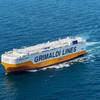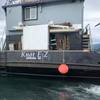Prior to the outbreak of WWII the Japanese began construction of several different types of midget submarines. Recognizing the strategic importance of such a weapon for combat use, Japan built hundreds of these "mini subs" ranging in size from just under 80 ft. to over 100 ft. Designed to carry a crew of 2 to 3 sailors and armed with two torpedoes, these small subs were originally intended to be transported on ships and deployed in the path of an enemy fleet.
However, very quickly the Japanese saw the advantages of using the mini subs for special operations inside enemy harbors where conventional submarines could not go. To enhance their stealth capability, the midget subs were modified to ride atop full size subs and be deployed at sea near the target location. Their compact size and shallow draft allowed them to easily penetrate coastal areas and harbors, and wreak severe damage. Mini subs were involved in the attack on Pearl Harbor, and in raids on Sydney, Australia and Diego Suarez in the Indian Ocean. In 1942/43 the boats were deployed off Guadalcanal where they achieved modest success against US shipping. By the mid 1940's the mini subs were a scourge feared by allied forces.
To defend against these midget subs, the allies began constructing sub detection networks along the entrances to their key harbors. The networks consisted of cables laid down on the harbor floor that could detect the passage of a steel hull vessel over them. In some of the harbors miles of cable were laid down. Today, more than 50 years after the war, many of the countries that still have these detection networks are having them removed for a variety of reasons. One is that many ports are expanding or having their harbors dredged deeper to accommodate today's larger ships. The cables are an obstacle to dredging operations and a potential hazard for ships anchoring. Another reason for removing the cables is their enormous scrap value. Most of the cables were constructed of copper, but with copper in such short supply during the war years, some were actually made of silver with the intent of reclaiming them after the war. However, very little salvage was ever done. Consortiums of private investors and government officials are now being formed to locate and remove these cables.
One of the companies performing this service is Resolve Marine Group in Port Everglades, Fla.
Resolve has been providing a variety of marine services to companies and government agencies in the U.S., Central and South America, and throughout the Caribbean for the past 20 years. The company's roots are in salvage and wreck removal, which remains one their specialties, but they have also expanded into a number of other areas. Their transportation division provides tug and barge services to distressed vessels including oil and chemical tankers, and in 1994 Resolve Fire & Hazard Response was established to provide state-of-the-art shipboard fire fighting training. The company maintains it's own specially trained firefighting team ready to respond at a moments notice. Recently Resolve was contracted to determine the location of sub detection cables on the bottom of the harbor leading to the Pacific entrance of the Panama Canal. A group of investors and Panamanian officials are collaborating to find and salvage the cables for their scrap value.
Resolve contracted JW Fishers to supply the needed detection equipment. A Proton 4 boat-towed magnetometer, TOV-1 towed underwater camera system, and Pulse 8X diver-held metal detector were selected for the job. The Proton 4, a powerful torpedo shaped metal detector that is towed behind the boat, would be ideal for the initial site survey. Although the magnetometer is not capable of detecting the copper or silver inside the cable, it's extreme sensitivity to iron and steel objects allows it to detect the cable's armoring at a considerable range.
Using the underwater camera the group could do a visual survey of the area where the cable was located, and the hand-held metal detector would help the divers precisely pinpoint each cable.
Resolve's operations supervisor, Kevin Shore, came to Fishers factory for training on the operation of the equipment before putting it on a plane to Panama that evening. After two weeks on-site Kevin called the factory and reported, "The first part of our survey operation has been completed. Our mission was to locate and confirm the existence of antisubmarine warfare magnetic loop installations dating from 1942 in the Bahia de Panama. Your equipment has performed beautifully. We successfully pinpointed the location of three cables. The ability to communicate with JW Fisher personnel and follow their suggestions helped our operation run smoothly and prevented delays. The Proton 4 Tracker software showing the GPS plot of the search grid, allowed us to make very efficient use of towing time, and made reviewing the resulting files of almost 2 million mag readouts a much easier task." Kevin went on to add, "Besides finding the cables, two shipwreck sites were discovered that we hope to investigate further in the near future."
Sponsored Content
The Future of the Advanced Measurement Industry: A Vision of Precision, Safety, and Reliability

August 2025
 Read the Magazine
Read the Magazine

 Read the Magazine
Read the Magazine
This issue sponsored by:

Washington Watch – Water Carrier Statutes & Regulations
Subscribe for
Maritime Reporter E-News
Maritime Reporter E-News is the maritime industry's largest circulation and most authoritative ENews Service, delivered to your Email five times per week








